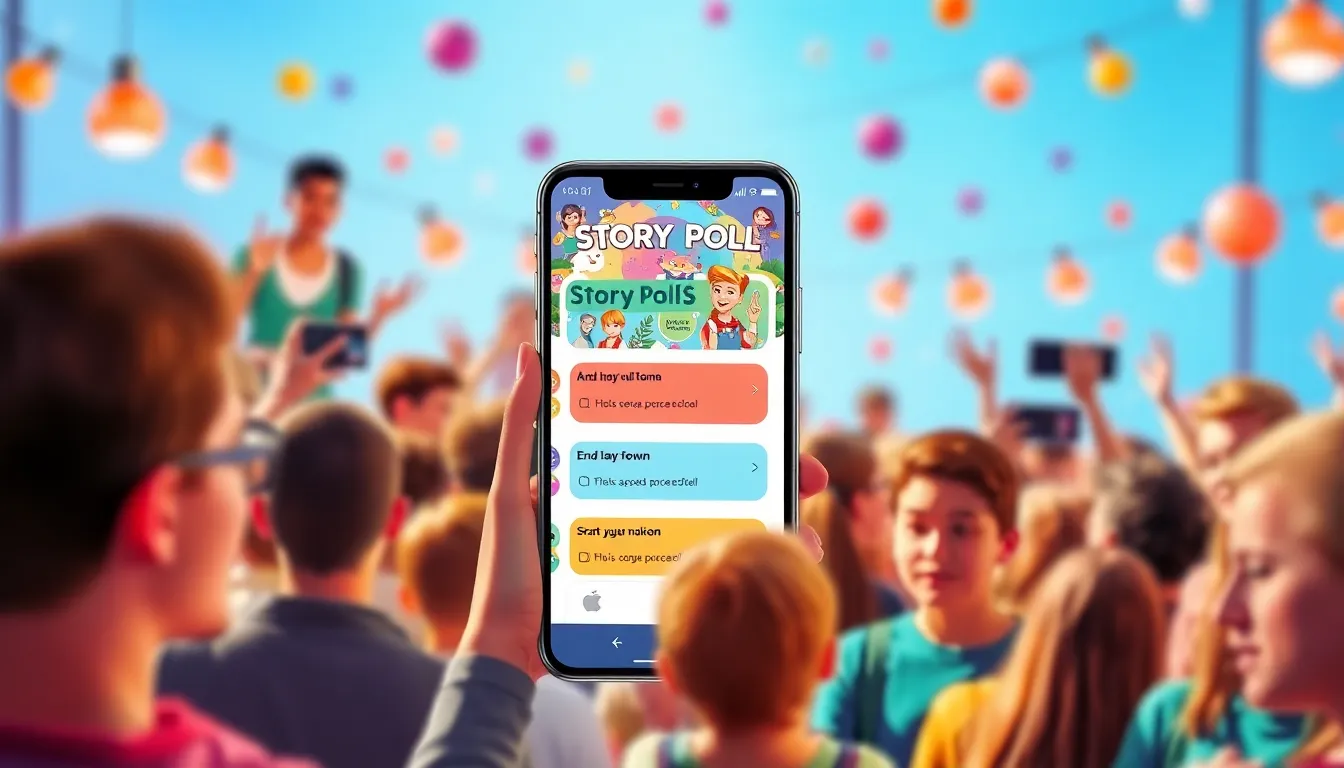In the fast-paced world of social media, engaging your audience can feel like trying to catch a greased pig. Enter the story poll strategy—a game-changer that not only boosts interaction but also gives followers a voice. Imagine turning mundane updates into lively conversations where your audience feels like they’re part of the action.
Story polls aren’t just a fun gimmick; they’re a powerful tool for gathering insights and sparking creativity. With a sprinkle of humor and a dash of strategy, they can transform your content from “meh” to “wow.” So buckle up and get ready to dive into the art of crafting compelling story polls that’ll have your audience eagerly tapping away and coming back for more.
Table of Contents
ToggleOverview of Story Poll Strategy
Story polls effectively engage social media audiences by fostering interactive conversations. Users can participate in real-time, allowing brands to enhance community interaction. Polls help transform standard updates into valuable engagement tools, inviting feedback and opinions from followers.
Data shows that interactive content increases user engagement by up to 80%. Creating compelling polls captures attention and encourages participation, making followers feel more connected to the brand. These polls also aid in gaining insights about audience preferences, informing future content strategies.
Additionally, using visuals alongside polls boosts engagement rates significantly. By leveraging eye-catching images or videos, brands attract more responses. Marketers can also analyze poll results to tailor content and generate more relevant discussions based on audience interests.
During the creation process, emphasizing clarity is essential. Users should easily understand the questions asked, enhancing the likelihood of participation. Brands should also consider timing when posting polls. Optimal posting times vary based on audience behavior, leading to higher response rates.
Incorporating a mix of fun and informative questions keeps content fresh. Variety in polls not only entertains but also educates audiences. Frequent analysis of poll data helps brands refine their strategies and improve audience connection, making story polls an invaluable aspect of digital marketing.
Adopting story polls as part of a broader engagement strategy encourages brands to build lasting relationships. These tools empower audiences, allowing them to influence content and feel valued. As engagement levels rise, brands can expect to see an increase in overall loyalty and conversions.
Benefits of Story Poll Strategy

Story polls offer multiple advantages for social media engagement, enhancing interactions between brands and audiences. They create dynamic conversation opportunities and allow followers to share their opinions, making them feel valued and involved.
Engagement Boost
Incorporating story polls into content can significantly heighten engagement. Research indicates that interactive content can lead to an 80% increase in user participation. Polls attract attention and encourage active responses. Their visually appealing format captures interest more effectively than regular posts. With clear and concise questions, brands can drive greater participation rates. Embracing a strategy that leverages these elements fosters a vibrant dialogue with the audience, ultimately transforming passive viewers into active participants.
Audience Insights
Understanding audience preferences becomes easier with story polls. By analyzing poll results, brands gain direct feedback on what followers want. This data reveals trends and interests that might not be obvious through standard metrics. Asking targeted questions helps brands identify specific content types that resonate most. Continuous monitoring of audience responses informs future strategies, fostering a deeper connection and loyalty. Utilizing story polls effectively turns follower insights into actionable strategies that enhance overall engagement.
Best Practices for Implementing Story Poll Strategy
Implementing a story poll strategy effectively requires attention to detail and understanding of audience dynamics. Select the right platform and craft engaging questions to maximize engagement.
Choosing the Right Platforms
Platforms such as Instagram and Facebook excel in supporting story polls. Instagram Stories offer a user-friendly interface and high engagement rates, making it ideal for polls. Facebook Stories also allow sharing with wider audiences, increasing exposure. Each platform has unique features, so brands should assess audience preferences before committing. By understanding where the target demographic engages most, brands can focus on platforms that yield the highest participation.
Crafting Appealing Poll Questions
Appealing questions captivate audience attention and drive participation. Simple language encourages quick responses, while clear wording eliminates confusion. Brands can mix fun and informative content to maintain interest over time. Posing relatable scenarios or asking about preferences can spark engagement. Including visuals alongside poll questions can enhance appeal and attract more responses. Regularly updating poll themes keeps content fresh, fostering a continuous dialogue with followers.
Analyzing Results from Story Polls
Analyzing results from story polls reveals crucial audience insights and trends. Brands can track participation rates, noting how many users engaged with each poll. This quantitative data provides a baseline for understanding overall interest levels.
Qualitative feedback is equally important; reading user comments offers deeper context. Companies should examine responses to gauge sentiment surrounding various topics. Which questions resonated most? Knowing this enables brands to adapt content accordingly, maximizing relevance.
Patterns in responses may indicate preferences for specific subjects or formats. By categorizing feedback, businesses can tailor future polls and content themes. Engaging followers based on their expressed interests fosters loyalty and enhances relationships.
Visual representation of poll data enhances clarity. Charts or graphs can illustrate trends, making it easier for brands to digest conclusions. Sharing top results with audiences can also increase transparency, showing followers that their opinions matter.
Timing is another factor to consider. Analyzing when polls were posted reveals peak engagement periods. Adjusting posting schedules based on this information increases the likelihood of higher participation rates.
Aggregating data over time strengthens future strategies. Companies can adopt an iterative approach, refining their poll questions and formats based on past performance. Analyzing these results systematically contributes to ongoing improvement in audience engagement efforts.
Monitoring changes in interaction allows brands to stay relevant. By assessing whether engagement rises or falls with different themes, organizations can pivot strategies as needed. Consistent evaluation empowers brands to foster meaningful connections with audiences, ultimately driving conversions.
Embracing a story poll strategy can revolutionize how brands engage with their audiences. By fostering interactive conversations and encouraging participation, brands not only capture attention but also build lasting relationships. The combination of appealing visuals and well-crafted questions enhances user experience and satisfaction.
Monitoring responses and analyzing feedback allows brands to refine their content strategies effectively. This continuous improvement leads to deeper connections and increased loyalty. Ultimately, incorporating story polls into social media strategies empowers brands to create meaningful interactions that drive conversions and enrich audience engagement.





